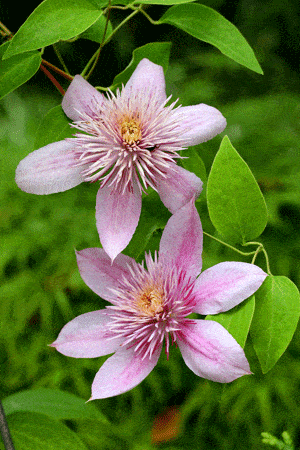
Is there anything to think about but the heat and the drought? There haven’t been water restrictions in my community, so I’ve made an effort to water the gardens, back and front, all through the days and nights of this miserable weather. I certainly don’t enjoy this, but hope it will make the late summer and early autumn weeks more worthwhile. I know from experience that when my garden goes through a drought, the damage takes a long time to repair. The clay soil constricts and hardens so effectively that cracks appear in the lawn and water just rolls away. Keeping up the irrigation prevents the clay from shrinking into dried concrete.
Of course, that means I’m outside more often, and can keep track of what’s going on. The petal colours of perennials grown in sunny locations are fading, bleached by the hot sun. Mauve phlox ‘Franz Schubert’ has no trace of purple and the petals have faded to dull cream. The violet-indigo Durand’s clematis (Clematis x durandii) is thickly suffused with grey. The new hybrid Empress clematis (C. ‘Evipo011’, Zone 5), with light pink tepals carrying a centre bar of raspberry pink, is growing in partial shade and still attractive, but the raspberry bars are fading as if the pigment is draining away.
But white flowers seem to flourish in the extreme conditions (provided they have sufficient water). White ‘David’ phlox is blazing in bright light, and so is a yellow-throateAdd Mediad white hollyhock, a self-sown seedling of a red parent. ‘Marie Boisselot’ clematis is spectacular, smothered with five-inch (13-cm) gleaming white flowers, unphased by heat or drought. The abundance of so many petals on one vine indicates that this plant requires a lot of moisture to keep up the show, and I make sure it has a big drink every day. This is an old cultivar of the Lanuginosa group bred in 1885, and has two purple parents, ‘The President’ and ‘Jackmanii’, in its genetic lineage. ‘Marie Boisselot’ blooms in my garden from early July through mid-August, a long run of dependable flowering, and the flowers appear on both new and old wood. I have it growing on a six-foot (1.8-cm) support, and let it cascade down after it reaches the top. In early spring I cut off the length of vines that have cascaded downward, and then check the remaining six feet on the support for buds that look promising. Whatever is healthy and budded remains. Then I give the vine one feeding of perennial plant fertilizer (whatever is on hand in the garage). I think it would be smart to plant another ‘Marie Boisselot’ next year, in the back garden, to provide encouragement for the hose-dragging gardener.
Moving on to better days
I have to believe that once this cycle of heat and drought is finished, better days are ahead for the garden. There’s going to be a need for serious plant grooming, deadheading, removing toasted foliage and staking up whatever has fallen down. It would also be useful to provide a nourishing meal of organic nutrients to help plants mend their stressed tissues. I’m going to invest in several bags of composted manure and give a generous two shovelfuls to perennials and shrubs to help them replenish resources and have a healthy autumn season. The effects of summer drought often show up in excessive winter dieback and I’d like to prevent that at any cost.
If you’re growing tomatoes and peppers, they may drop blossoms during the hot weather and will try to catch up with production when more moderate temperatures arrive. They’ll especially appreciate a fertilizer meal at that time, to help boost flower and fruit production. My cayenne pepper plants growing in containers (‘Long Slim Red’) have done almost nothing for the past three weeks, just holding on and waiting for more favourable conditions. I moved them into partial shade for some protection and the few peppers already hanging on the plants seem in good condition, but I know they can produce up to 50 fruits on each plant. I’m already hot enough and don’t want them for spicing up dinner, but it would be nice to open a jar of red pepper jelly in January or February.

Hi Tracy (July 30),
Glad to know your salsa garden is in good shape and productive!
— Judith
Hi Laurie (July 28),
It seems we gardeners are never satisfied. I think the wet and dry weather patterns were better balanced back in the 1980s. Or perhaps I’m not remembering accurately. The past few years seem to have brought us various kinds of stress conditions, and we’re always struggling with unexpected drought, excessive rain, heat, hail and next, a plague of toads! We need to build resiliency into our gardens, so recovery is possible no matter what weather comes our way.
— Judith
Hi M.Lauriston (July 28),
Snow? Oh yes, the cold white stuff. You’re right! I should have planted red pelargoniums. Next year I’ll get it right.
— Judith
Funny, my Jalapeños are loving the sun and heat. They and the tomatoes are in a sheltered spot that gets early morning and late afternoon sun. They’re loving it!
White flowers may be great, but after a winter of staring at the snow I prefer color!
I would really love some consistent warm weather and would take a drought about now…we seem to get a couple of days of nice sunny weather followed by a couple of days of torrential downpours. So long lilies – they are just too wet this year and I am doubtful that they will be back next year. My beds were looking not too bad and then the hail came and shredded everything! Careful what you wish for.